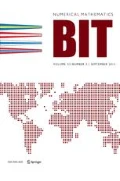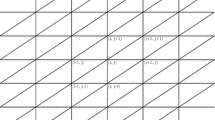Abstract
A new non-conforming finite element method is proposed for the approximation of the biharmonic equation with clamped boundary condition. The new formulation is based on a gradient recovery operator. Optimal a priori error estimates are proved for the proposed approach. The approach is also extended to cover a singularly perturbed problem.


Similar content being viewed by others
References
Ainsworth, M., Oden, J.T.: A posteriori error estimation in finite element analysis. Wiley-Interscience, New York (2000)
Babuška, I., Osborn, J., Pitkäranta, J.: Analysis of mixed methods using mesh dependent norms. Math. Comput. 35, 1039–1062 (1980)
Bank, R., Xu, J.: Asymptotically exact a posteriori error estimators, part I: grids with superconvergence. SIAM J. Numer. Anal. 41, 2294–2312 (2003)
Bank, R., Xu, J.: Asymptotically exact a posteriori error estimators, part II: general unstructured grids. SIAM J. Numer. Anal. 41, 2313–2332 (2003)
Braess, D.: Finite elements: theory, fast solver, and applications in solid mechanics, 2nd edn. Cambridge University Press, Cambridge (2001)
Brandts, J.: Gradient superconvergence on uniform simplicial partitions of polytopes. IMA Journal of Numerical Analysis 23, 489–505 (2003)
Brenner, S.C., Scott, L.R.: The mathematical theory of finite element methods. Springer, New York (1994)
Brenner, S.C., Sung, L.: Linear finite element methods for planar linear elasticity. Math. Comput. 59, 321–338 (1992)
Brenner, S.C., Sung, L.-Y.: \(C^0\) interior penalty methods for fourth order elliptic boundary value problems on polygonal domains. J. Sci. Comput. 22–23, 83–118 (2005)
Chen, J., Wang, D.: Three-dimensional finite element superconvergent gradient recovery on par6 patterns. Numerical Mathematics: Theory, Methods and Applications 3, 178–194 (2010)
Chen, L.: Superconvergence of tetrahedral linear finite elements. Int. J. Numer. Anal. Model. 3, 273–282 (2006)
Cheng, X., Han, W., Huang, H.: Some mixed finite element methods for biharmonic equation. J. Comput. Appl. Math. 126, 91–109 (2000)
Ciarlet, P.G.: The finite element method for elliptic problems. North Holland, Amsterdam (1978)
Ciarlet, P.G., Raviart, P.-A.: Symposium on mathematical aspects of finite elements in partial differential equations. In: De Boor, C. (ed.) A mixed finite element method for the biharmonic equation, pp. 125–143. Academic Press, New York (1974)
Engel, G., Garikipati, K., Hughes, T.J.R., Larson, M.G., Mazzei, L., Taylor, R.L.: Continuous/discontinuous finite element approximations of fourth-order elliptic problems in structural and continuum mechanics with applications to thin beams and plates, and strain gradient elasticity. Comput. Methods Appl. Mech. Eng. 191, 3669–3750 (2002)
Falk, R., Osborn, J.E.: Error estimates for mixed methods. RAIRO Anal. Numér. 14, 249–277 (1980)
Falk, R.S.: Approximation of the biharmonic equation by a mixed finite element method. SIAM J. Numer. Anal. 15, 556–567 (1978)
Girault, V., Raviart, P.-A.: Finite element methods for Navier–Stokes equations. Springer, Berlin (1986)
Han, H., Wu, X.: A new mixed finite element formulation and the MAC method for the Stokes equations. SIAM J. Numer. Anal. 35, 560–571 (1998)
Johnson, C., Pitkäranta, J.: Some mixed finite element methods related to reduced integration. Math. Comput. 38, 375–400 (1982)
Kim, C., Lazarov, R.D., Pasciak, J.E., Vassilevski, P.S.: Multiplier spaces for the mortar finite element method in three dimensions. SIAM J. Numer. Anal. 39, 519–538 (2001)
Lakhany, A.M., Marek, I., Whiteman, J.R.: Superconvergence results on mildly structured triangulations. Comput. Methods Appl. Mech. Eng. 189, 1–75 (2000)
Lamichhane, B.P.: Higher order mortar finite elements with dual Lagrange multiplier spaces and applications. PhD thesis, Universität Stuttgart (2006)
Lamichhane, B.P.: A gradient recovery operator based on an oblique projection. Electron. Trans. Numer. Anal. 37, 166–172 (2010)
Lamichhane, B.P.: A stabilized mixed finite element method for the biharmonic equation based on biorthogonal systems. J. Comput. Appl. Math. 235, 5188–5197 (2011)
Lamichhane, B.P.: Two simple finite element methods for Reissner–Mindlin plates with clamped boundary condition. Appl. Numer. Math. 72, 91–98 (2013)
Lamichhane, B.P., McNeily, A.: Approximation properties of a gradient recovery operator using a biorthogonal system. http://arxiv.org/abs/1305.0089, 2013. (Submitted)
Li, B., Zhang, Z.: Analysis of a class of superconvergence patch recovery techniques for linear and bilinear finite elements. Numer. Methods Partial Differ. Equ. 15, 151–167 (1999)
Lysaker, M., Lundervold, A., Tai, X.C.: Noise removal using fourth-order partial differential equation with applications to medical magnetic resonance images in space and time. IEEE Trans. Image Process. 12, 1579–1590 (2003)
Nilssen, T.K., Tai, X.-C., Winther, R.: A robust nonconforming \({H}^2\)-element. Math. Comput. 70, 489–505 (2000)
Wahba, G.: Spline models for observational data. In: Series in applied mathematic, 1st edn. SIAM, Philadelphia (1990)
Wells, G.N., Kuhl, E., Garikipati, K.: A discontinuous Galerkin method for the Cahn–Hilliard equation. J. Comput. Phys. 218, 860–877 (2006)
Xu, J., Zhang, Z.: Analysis of recovery type a posteriori error estimators for mildly structured grids. Math. Comput. 73, 1139–1152 (2004)
Zhang, Z.: Ultraconvergence of the patch recovery technique. Math. Comput. 65, 1431–1437 (1996)
Zhang, Z.: Ultraconvergence of the patch recovery technique II. Math. Comput. 69, 141–158 (2000)
Zhang, Z., Zhu, J.Z.: Analysis of the superconvergent patch recovery technique and a posteriori error estimator in the finite element method (II). Comput. Methods Appl. Mech. Eng. 163, 159–170 (1998)
Acknowledgments
I am grateful to the anonymous referees for their valuable suggestions to improve the quality of the paper.
Author information
Authors and Affiliations
Corresponding author
Additional information
Communicated by Ragnar Winther.
Rights and permissions
About this article
Cite this article
Lamichhane, B.P. A finite element method for a biharmonic equation based on gradient recovery operators. Bit Numer Math 54, 469–484 (2014). https://doi.org/10.1007/s10543-013-0462-0
Received:
Accepted:
Published:
Issue Date:
DOI: https://doi.org/10.1007/s10543-013-0462-0
Keywords
- Biharmonic equation
- Clamped boundary conditions
- Strang’s lemma
- Nonconforming method
- A priori estimate
- Biorthogonal system




